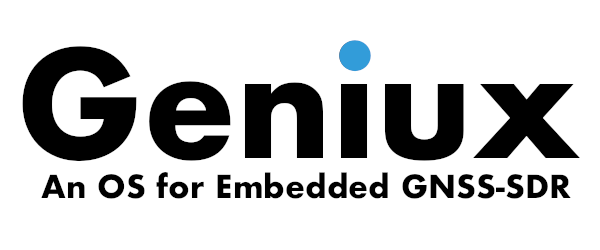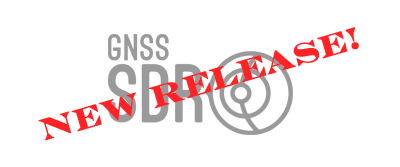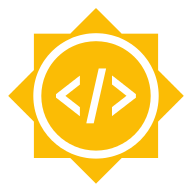Google Summer of Code 2018 ideas list
This year, GNSS-SDR has been accepted as a mentoring organization for Google Summer of Code (also known as GSoC), a global program that offers students stipends to write code for open source projects. In order to participate in the program, you must be a student. Google defines a student as an individual enrolled in or accepted into an accredited institution including (but not necessarily limited to) colleges, universities, masters programs, PhD programs and undergraduate programs. You should be prepared, upon request, to provide Google with transcripts or other documentation from your accredited institution as proof of enrollment or admission status. Computer Science does not need to be your field of study in order to participate in the program. You may be enrolled as a full-time or part-time student for a time period that includes April 23, 2018, and must be at least 18 years old to be eligible to participate in Google Summer of Code in 2018.
If you are an eligible and interested student, read through the list and note the projects you are interested in. You, as the student programmer, then submit a proposal to Google, using the GSoC 2018 website. The application form for students will be open from March 12 16:00 UTC until March 27 16:00 UTC. We recommend you to submit your application early. By doing so, it will be given a greater share of attention than is possible for applications submitted at the last minute.
You might submit a proposal following the guidelines below, or you might want to adapt them to your needs. Changes to the proposal could include:
-
You think the project as suggested is too large and you can only feasibly complete part of it; if so, make sure your proposal covers a reasonable subset of the functionality (that is, something which is useful without the rest of the project being implemented).
-
You think the project as suggested is too small; in this case you might want to extend the idea, combine projects, etc.
-
You like the basic idea of the project but it is not such a good fit for the skills that you have; in this case please feel free to suggest an alternative, but try to remember that the idea is for the software to be useful for its existing and potential users.
Your proposal should include the following: your project proposal, why you would like to execute on this particular project, and the reason you are the best individual to do so. Your proposal should also include details of your academic, industry, and/or open source development experience, and other details as you see fit. An explanation of your development methodology and schedule is a good idea, as well. It is always helpful to include your contact information, as it will not be automatically shared with your would-be mentors as part of the proposal process.
Hereafter we list, in no particular order, some proposals for projects to be carried out by the students participating in GSoC 2018. This is by no means a closed list, so the students can feel free to propose alternative activities related to the project.
Robust Kalman Filter-based Tracking Techniques for Advanced GNSS Receivers
Description:
Tracking of synchronization parameters (i.e., time-delay and carrier phase) is a key step in the core of any GNSS receiver. The current tracking block implementations, which are fully operational in GNSS-SDR for GPS L1, GPS L2, GPS L5, Galileo E1, Galileo E5a and GLONASS L1 bands, are based on traditional tracking loop architectures (e.g., DLL and PLL). Those techniques are prone to fail in non-nominal propagation conditions such as high-dynamics, shadowing, strong fadings, multipath effects or ionospheric scintillation. It is known that Kalman filter (KF)-based techniques, which are formulated from an optimal filtering standpoint, are more robust to such harsh propagation conditions, thus being the methods of choice in advanced GNSS receivers.
The main goals of this project are: i) to develop and integrate into the GNSS-SDR core standard (discriminator-based) KF tracking techniques for both (joint) code and phase tracking; ii) extend such standard KFs to adaptive KF tracking, for instance, sequentially adjusting the measurement covariance at the output of the discriminators; iii) implement discriminator-free extended KF (EKF) solutions, and iv) to test and compare the performance of these techniques with respect to traditional architectures using real signals.
Skills required:
Good understanding of statistical signal processing and C++ programming (familiarity with the GNU Radio framework and Kalman filtering techniques is a plus).
Potential mentor(s):
Dr. Jordi Vilà-Valls, Dr. Pau Closas, Dr. Javier Arribas.
Optimal frame synchronization detection
Description:
GNSS data demodulation is preceded by frame synchronization. This process is critical, since it may prevent data recovery if not sufficiently reliable. Currently, GNSS-SDR implements a hard correlation scheme where correlation with the known pattern is performed. Although useful due to is simplicity, there are no performance guarantees for such approach. Particularly, in low signal-to-noise ratio (SNR) situations the performance of such correlation may degrade. This situations occur, for instance, in the presence of jamming signals. The goal of the project will be to implement an optimal detector, based on Massey’s frame synchronization metric. Characterization of its performance and comparison to the current method in a number of SNR conditions.
J. L. Massey, Optimum frame synchronization, IEEE Trans. Commun., vol. 20, no. 2, pp. 115–119, April 1972.
Skills required:
Basic knowledge on digital signal processing and C++ programming (familiarity with the GNU Radio framework is a plus).
Potential mentor(s):
Dr. Pau Closas, Dr. Jordi Vilà-Valls, Dr. Monica Navarro.
Acquisition and Tracking GNU Radio blocks for different data types
Description:
As discussed at Issue #75, it would be nice to have a mechanism to avoid duplication of code when implementing Acquisition and Tracking blocks for different data types. This project consists of designing a suitable solution (based on templates or any other proposed approach, to be discussed) and implementing it for the existing blocks. Including a first draft of such design and discussing its Pros and Cons in the proposal will be highly appreciated.
Skills required:
Solid knowledge on C++ programming (familiarity with the GNU Radio framework is a plus).
Potential mentor(s):
Dr. Carles Fernández-Prades, Dr. Javier Arribas, Mr. Luis Esteve.
Graphical User Interface for GNSS-SDR configuration
Description:
The configuration mechanism of GNSS-SDR allows users to define and configure each of the receiver’s signal processing blocks in a single file. Those configuration files constitute full receiver definitions, since they specify the implementation and parameters to be used in the receiver chain. However, the configuration process is poorly documented and only few baseline examples are provided. The objective of this project is to continue the development started in GSoC 2017 on a Graphical User Interface for the generation of such configuration files, allowing for an intuitive, user-friendly software receiver definition. That work is now in the gui branch of the upstream repository.
Skills required:
Good understanding of digital signal processing and C++ programming (familiarity with the GNU Radio framework and Qt is a plus).
Potential mentor(s):
Dr. Javier Arribas, Mr. Luis Esteve, Dr. Carles Fernández-Prades.
Design and Implementation of a Graphical User Interface (GUI) to show the GNSS-SDR status in real-time
Almost all the commercial GNSS receivers come with an intuitive, easy to install and easy to use software that shows if your receiver is working properly or not. Examples of such software are the Google GNSS Analysis software and uBlox uCenter.
The minimum GNSS receiver information reported by the status software should be:
- GNSS Satellites on track
- Satellite ID and Constellation identification
- Satellite CN0 [dB-Hz]
- Elevation and Azimuth
- Satellite status (telemetry received and status flags)
- Position, Velocity and Time (PVT)
- UTC and GPS time
- Latitude and Longitude in WGS84
- Ground Speed (m/s or km/h)
- Ground Course (degrees from true North)
- Ground track using on-line map provider (optional)
In addition, due to the inherent flexibility of a software receiver, GNSS-SDR is capable of providing detailed information of the internal status of each of the GNSS receiver modules, hereafter are listed some of the several possibilities:
- Acquisition module information
- Acquisition test statistics value vs. threshold for each satellite
- Acquisition grid plot
- Tracking module information per channel
- Correlators output plot (e.g Early, Prompt and Late absolute value)
- BPSK Constellation plot and Telemetry symbols timeline plot
- CN0 plot
- Tracking loop parameters (DLL, PLL bandwidths and correlator spacing)
- Telemetry decoder information per channel
- Frame synchronization status
- Reverse phase lock flag
- Frame CRC status
- Decoded Ephemeris information
- Observables information
- Code Pseudorange [m]
- Accumulated carrier phase [cycles]
- Doppler frequency [Hz]
- CN0 [dB-Hz]
- Cycle slips
- PVT solver information
- Corrected observables information
- RTKLIB internal status parameters
- Solver flags and log
- Kalman filter covariances
- Kalman filter states
- Extended PVT information
- ECEF P,V
- Receiver time offset
Regarding the receiver control, usually a GNSS GUI status software has the possibility to trigger a software reset to test Cold Start, Warm Start and Hot Start. GNSS-SDR can be modified to include such features.
The work proposed in this project consist on the one hand designing and implementing a non-invasive GNSS-SDR monitoring system that provides a real-time access to the internal GNSS-SDR modules receiver parameters, from an external application running either in local or remote machine. Such communication mechanism should be based on Boost serialization libraries or equivalent, over TCP or UDP connections, to speed up the development time. On the other hand, the GUI status software should be implemented as a standalone application that can be compiled and run in the following O.S:
- Windows
- Linux
- macOS
The C++ Qt 5 framework seems to be a suitable candidate to provide the required libraries to build forms, tables and plots in a multi-platform programming IDE.
Skills required:
Good understanding C++ programming (familiarity with the GNU Radio framework is a plus). Basic knowledge of the C++ Qt 5 framework.
Potential mentor(s):
Dr. Javier Arribas, Dr. Carles Fernández-Prades, Dr. Jordi Vilà-Valls.
Expanding the receiver to BEIDOU B1I
Description:
Objective by the end of the summer: To provide a working implementation of a GNSS receiver working with Beidou B1I signals, delivering RINEX files (the standard input of geodesic software libraries for high—accuracy positioning) and an on-the-fly navigation solution (that is, computation of position, velocity and time of the user’s receiver).
- Revision of acquisition and tracking algorithms developed for Beidou in past GSoC editions. This would facilitate research on multi-constellation receivers (e.g., GPS + Galileo + GLONASS + Beidou) working with real signals.
- Demodulation of the navigation message, opening the door to open innovation in multi-constellation receivers and addressing topics such as integrity, reliability, robustness, enhanced coverage, and high-accuracy positioning.
- Integration of Beidou observables into the PVT position.
Skills required:
Basic knowledge on digital signal processing and C++ programming (familiarity with the GNU Radio framework is a plus).
Potential mentor(s):
Mr. Luis Esteve, Mr. Damian Miralles, Mr. Antonio Ramos.
Expanding the receiver to BEIDOU B1C
Description:
Objective by the end of the summer: To provide a working implementation of a GNSS receiver working with Beidou B1C signals, delivering RINEX files (the standard input of geodesic software libraries for high—accuracy positioning) and an on-the-fly navigation solution (that is, computation of position, velocity and time of the user’s receiver).
- Implementation of acquisition and tracking algorithms for Beidou B1C signals, following the examples already implemented for other GNSS signals. This would facilitate research on multi-constellation, multi-frequency receivers (e.g., GPS + Galileo + Beidou) working with real signals.
- Demodulation of the navigation message, opening the door to open innovation in multi-constellation receivers and addressing topics such as integrity, reliability, robustness, enhanced coverage, and high-accuracy positioning.
- Integration of Beidou observables into the PVT position.
Skills required:
Basic knowledge of digital signal processing and C++ programming (familiarity with the GNU Radio framework is a plus).
Potential mentor(s):
Mr. Damian Miralles, Mr. Luis Esteve, Dr. Carles Fernández-Prades.
Expanding the receiver to BEIDOU B2a
Description:
Objective by the end of the summer: To provide a working implementation of a GNSS receiver working with Beidou B2a signals, delivering RINEX files (the standard input of geodesic software libraries for high—accuracy positioning) and an on-the-fly navigation solution (that is, computation of position, velocity and time of the user’s receiver).
- Implementation of acquisition and tracking algorithms for Beidou B2a signals, following the examples already implemented for other GNSS signals. This would facilitate research on multi-constellation, multi-frequency receivers (e.g., GPS + Galileo + Beidou) working with real signals.
- Demodulation of the navigation message, opening the door to open innovation in multi-constellation receivers and addressing topics such as integrity, reliability, robustness, enhanced coverage, and high-accuracy positioning.
- Integration of Beidou observables into the PVT position.
Skills required:
Basic knowledge of digital signal processing and C++ programming (familiarity with the GNU Radio framework is a plus).
Potential mentor(s):
Mr. Damian Miralles, Mr. Luis Esteve, Dr. Carles Fernández-Prades.
Proposal template:
- Student’s Name
- Email Address
- Name of the Project
- Summary: Short statement about your intents (100 words approx.).
- Benefits: What are the benefits of your proposal?
- Plan: Describe your work plan in detail (tasks and schedule). Would there be blackout days (vacations, short jobs, etc.)?
- Deliverables: What are you going to deliver and when?
- Communication: How will you communicate with your mentor and the developers community?
- Qualification: Why you are the best candidate for this project?



